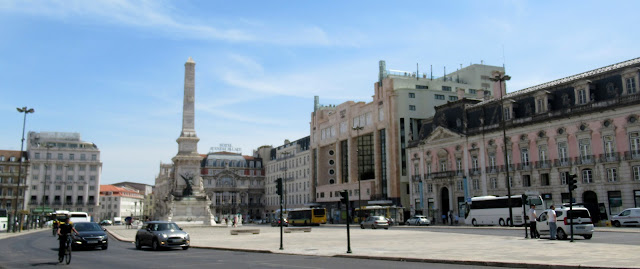Our exploration of this area in Lisbon started after we visited Fundacao Calouste Gulbekian where we looked at their permanent exhibition.
We walked along Avenida Antonio Augusto Aguiar

and reached Jarim Amalia Rodrigues, a small park named to honor the Fado singer Amalia Rodrigues. It is located on one of the highest points in the city, with magnificent views of the Baixa. This park is part of the Green Corridor, which links Park Eduardo VII to Monsanto.
Fado (literally 'fate') is often described as a kind of Portuguese blues. Popular themes are love, death bullfighting and indeed fate itself. It is believed to derive from music that was popular with 18th century immigrants from Portugal's colonies who first settled in Alfama.

Right by the entrance to this small park is Linha d'Agua, a delightful bar and restaurant and we decided to sit here for a while and have a drink
It was wonderful.
After approximately an hour we moved on through the very small park
and arrived at Alameda Do Cardeal Cerejeira, an avenue that divides the park from the next one, Parque Euardo VII
Maternidade by Fernando Botero
The main viewing platform of this steep park
The park was named to honour Britain's King Edward VII when he visited the city in 1903.
Two tree-lined avenues flank
the formally laid out central section
and the views of the Baixa and the river are stunning
the pavement, is of course, what else? mosaic
It was a hot day, 31oC, so walking in the shade of the trees, was welcome
Looking back
We reached Pavilhao Carlos Lopes, the main building, ornately tiled and built for the Internatioal Exhibition of Rio de Janeiro in 1922, then dismantled and rebuilt here in 1932
until we reached Praca Marques de Pombal, a very busy square
and then we were in the shade again,
on Avenida da Liberdade, a 1.3 km palm-lined avenue which is still as poet Fernando Pessoa described it:
'the finest artery in Lisbon... full of trees... small gardens, ponds, fountains, cascades and statues'.
It was laid out in 1882 as the city's main north-south avenue and has several appealing outdoor cafes beneath the shades of trees that help cushion the roar of traffic.
Some of the original 19th century mansions remain, though most have been replaced by modern buldings.
The upper end of the avenue (Lisbon's most expensive real estate) houses many of the city's designer shops
The
No to War banner is draped over the Communist Party headquarters
The mosaic in this small square that divides the avenue into two commemorates the discovery of America
some very exotic palm trees here
Finally, we reached Placa do Restauradores and then it was another 5 minute walk to our hotel.









































No comments:
Post a Comment